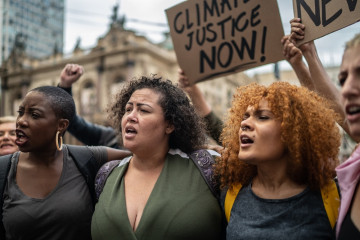In today's world, the term "environmental justice" (EJ) has gained remarkable prominence. With a renewed emphasis on addressing the needs of marginalized and minority communities, EJ has become an urgent and vital issue. Against the backdrop of intensifying efforts to combat climate change, the Biden administration has placed Environmental Justice and a "Just Transition" at the forefront of its strategy.
In our webinar, entitled “Equity in Action: Navigating the Environmental Justice Imperative,” Scott Recker, Environmental Remediation Practice Leader and Vice President at Antea Group leads a discussion on Environmental Justice with Bradford Conroy, Senior Professional, and Karly Beaumont, an Analyst within Antea Grtoup’s ESG Advisory Services Team. They provide a comprehensive framework for understanding the essence of Environmental Justice and offer a global perspective on how it intersects with ESG considerations and the broader context of climate change.
Additionally, they share actionable insights for organizations, enabling them to both comprehend and mitigate risks associated with Environmental Justice. By doing so, organizations can enhance their positioning within their communities and contribute to a more equitable and sustainable future.
Missed this webinar? Watch HereWhat is Environmental Justice?
Environmental justice is defined by the Environmental Protection Agency (EPA) as ”the fair treatment and meaningful involvement of all people regardless of race, color, national origin, or income, with respect to the development, implementation, and enforcement of environmental laws, regulations, and policies.”
David Pellow, author of “What is Critical Environmental Justice,” takes this a step further, explaining that not only does EJ ensure that no community bears a disproportionate burden of environmental harm and risks, but this social movement can also go beyond distributive justice to challenge the underlying power structures that disadvantage some communities to advantage others.
Why Do We Need to Address EJ?
Statistics underscore the urgency of addressing environmental injustices:
- Proximity to Contaminated Sites: First, 70% of the country's contaminated waste sites are located near low-income housing. This means that vulnerable communities are disproportionately exposed to environmental hazards.
- Vulnerable Communities: The EPA estimates that 1.5 million people of color live in areas vulnerable to contamination, according to Scientific American. These communities face a higher risk of health issues due to exposure to pollutants.
- Nature-Deprived Areas: American Progress reported that 74% of communities of color in the contiguous United States live in nature-deprived areas, compared to 23% of white communities. This lack of access to green spaces impacts overall well-being.
Government EJ Initiatives Happening Now
The Biden administration has made significant strides in advancing environmental justice. These initiatives include:
- Justice 40 Initiative: Announced one week into President Biden's term, this initiative aims to deliver at least 40% of the benefits of climate and clean energy investments to disadvantaged communities. It recognizes the historical disparities in environmental impact and seeks to rectify them.
- White House Environmental Justice Advisory Council: Established in March of the same year, this council focuses on addressing environmental injustices. It brings together experts and community leaders to inform policy decisions.
- Action Plan: In January 2022, an Action Plan was unveiled, featuring unannounced inspections, pollution accountability teams, grants, and state-specific actions. This plan is a concrete step towards rectifying environmental injustices.
- Federal Enforcement Priorities: In August, the EPA announced federal enforcement priorities to protect communities from pollution, which include measures to achieve environmental justice. This includes stricter regulations and enforcement to reduce the disproportionate burden on marginalized communities.
- Infrastructure Investment and Jobs Act: Passed in November 2021, this act earmarks billions of dollars for infrastructure, and 40% of those projects are required to go toward achieving environmental justice or directly benefitting disadvantaged communities.
- Inflation Reduction Act: Passed in August 2022, this act also sets aside billions of dollars to improve disadvantaged or underserved communities.
The Concept of a "Just Transition"
Another key part of EJ is “Just Transition." This is the shift from a carbon-based economy to a renewable-based economy while ensuring that no one is left behind. It involves creating decent job opportunities and addressing the needs of workers in transitioning industries, such as coal workers transitioning to renewable energy roles. This concept recognizes the importance of social equity in the transition to a sustainable future.
The Role of ESG Principles
ESG (Environmental, Social, and Governance) is one of the many mechanisms to implement principles from movements such as environmental justice into actionable items, such as through compliance, disclosure, strategy, and sustainability reports. ESG encompasses various aspects, including climate change, human rights, and ethical governance. These principles align with environmental justice goals, emphasizing the importance of sustainability and social responsibility.
Human Rights and ESG
Human rights, including the right to a healthy environment, are integral components of ESG and EJ. Businesses are increasingly incorporating environmental topics into their human rights policies, recognizing their impact on various rights and protections. This includes addressing issues like pollution and access to clean water as human rights concerns.
How are Disadvantaged Communities Identified?
Identifying disadvantaged communities involves considering several factors, including climate change, housing, energy, legacy pollution, health, transportation, and water and wastewater infrastructure. These factors contribute to the vulnerability of certain communities to environmental hazards and injustices.
Tools for Evaluating Environmental Justice Risks
The EPA provides various tools to evaluate environmental justice risks, including:
- Enforcement and Compliance History Online (ECHO): This tool helps assess environmental compliance status for specific facilities. It allows businesses to track their environmental performance and compliance with regulations.
- EPA EJSCREEN Tool: A geospatial tool that ranks areas based on environmental justice risk, aiding in risk assessment. It considers factors like pollution sources and demographic information to identify areas with higher environmental justice risks.
- Climate and Economic Justice Screening Tool (CEJST): This tool designates areas as disadvantaged, potentially eligible for funding under specific legislation. It helps businesses determine whether they operate in or near communities that may qualify for support.
- EnviroScreen: A California-specific tool that goes further in assessing environmental justice risks within an area. It considers multiple environmental risks and provides a more comprehensive understanding of environmental disparities.
How can you Prepare for Environmental Justice Risks?
As a business, now is the time to start evaluating your EJ risks and boost your resiliency. Preparing for environmental justice risks involves a Plan-Do-Check-Act process. It includes being ready, understanding risks, prioritizing vulnerabilities, making a plan, engaging with the community, and continuously improving practices.
- Be Ready: Businesses should ensure their documentation is organized and compliant with environmental regulations. Publicly available compliance documents should be up to date to avoid negative public perception.
- Know Your Situation and Identify Your Risks: Understanding the environmental justice risks associated with your location and industry is crucial. It helps businesses make informed decisions and take targeted actions to mitigate risks.
- Prioritize and Monetize Vulnerabilities: Prioritizing vulnerabilities helps businesses allocate resources effectively. Assessing the potential financial impact of environmental justice risks allows for better planning and budgeting.
- Make a Plan: Developing an actionable plan that includes a schedule and budget is essential. It ensures that mitigating environmental justice risks becomes an integral part of business operations.
- Engage with Your Community: Community engagement is key to understanding how local communities perceive your business. It helps build trust and foster a positive relationship between the business and its surroundings.
- Continuously Improve: After implementing risk mitigation measures, it's essential to continuously assess and improve practices. Businesses should learn from their experiences and seek opportunities for collaboration with communities and NGOs.
Conclusion
Environmental justice is gaining momentum as governments, businesses, and communities recognize its importance. It involves addressing environmental disparities, engaging with communities, and implementing ethical practices. Businesses must evaluate their exposure to environmental justice risks and take proactive steps to minimize them, all while aligning with the principles of ESG and promoting sustainability and social responsibility. The landscape of environmental justice is evolving, and businesses that embrace it can contribute to a more equitable and sustainable future for all.
Rethinking EHS Podcast: An Episode on Environmental Justice
Have any questions?
Contact us to discuss your environment, health, safety, and sustainability needs today.






